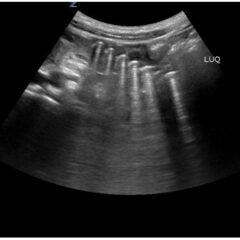E-FAST Ultrasound Training Curriculum for Prehospital Emergency Medical Service (EMS) Clinicians
ABSTRACT:
Audience and Type of Curriculum:
Audience and type of curriculum: This hybrid, asynchronous curriculum is designed for prehospital clinician colleagues, including but not limited to emergency medical technicians (EMT), advanced EMTs (AEMT), EMT-paramedics (EMT-P), critical care EMT-Ps (CCEMTP), critical care transport nurses (CCTN), and certified flight registered nurses (CFRN) to learn and practice ultrasound fundamentals in the setting of a standardized extended focused assessment with sonography in trauma (E-FAST) exam.
Length of Curriculum:
Over a five-month curriculum, learners will perform a pre-test, review online module lectures, attend an ultrasound scanning workshop, and perform post-test examinations.
Introduction:
The extended-focused assessment with sonography in trauma (E-FAST) exam can identify intrathoracic and intraabdominal free fluid, as well as pneumothoraces. The E-FAST ultrasound exam has previously been taught to clinicians of various backgrounds in healthcare including emergency medical service (EMS). However, an open-access, systemized curriculum for teaching E-FAST exams to EMS clinicians has not been published.
Educational Goals:
By the end of these training activities, prehospital EMS learners will be able to demonstrate foundational ultrasound skills in scanning, interpretation, and artifact recognition by identifying pertinent organs and anatomically relevant structures for an E-FAST examination. Learners will differentiate between normal and pathologic E-FAST ultrasound images by identifying the presence of free fluid and lung sliding. Learners will also explain the clinical significance and application of detecting free fluid during an E-FAST scan.
Educational Methods:
The educational strategies used in this curriculum include a hybrid, asynchronous curriculum encompassing 2.5 hours of lectures derived from online learning modules and in-person review. In addition, learners will attend 2 hours of hands-on proctored ultrasound scanning practicing E-FAST examinations.
Research Methods:
An online 13-question pre-test was administered prior to the study. An online post-test and in-person scanning OSCEs were administered at least eight weeks after their scheduled workshop consisting of an online 13-question multiple-choice post-test, a confidence survey, and a hands-on E-FAST Objectively Structured Clinical Exam (OSCE) session. A non-parametric Wilcoxon signed-rank test was performed between each pre-test and post-test metric to examine the statistical differences of paired data.
Results:
Post-test scores demonstrated statistically significant improvement in both image interpretation exams and ultrasound self-efficacy from the pre-test. The mean pre-test and post-test scores were 55.46% (7.21 ± 1.99) and 84.23% (10.89 ± 1.59) correct out of 13 questions, respectively (p < 0.0001). Participants surveyed an increase in self-efficacy reflected by a Likert scale for ultrasound usage and image interpretation (p < 0.005). The average post-test OSCE E-FAST exam score was 37.89 ± 2.76 out of 42 points (90.21%).
Discussion:
This 4.5-hour hybrid asynchronous model demonstrates an effective curriculum for teaching E-FAST ultrasound to prehospital clinicians.
Topics:
Ultrasound, sonography, prehospital clinicians, emergency medical services (EMS), paramedics, critical care transport, extended focused assessment with sonography in trauma (E-FAST), free fluid, sliding lung sign, elective, pain.

